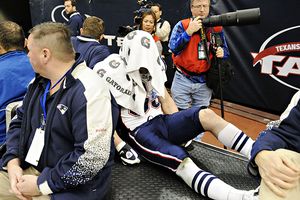Irvine's Vizio Inc. is getting ready to release its LED-backlit TV for $1,500 less than its competitors' sets.
By: David Colker
The future of television could be sitting in an Irvine laboratory.
To illuminate images, these sets use light-emitting diodes behind the screen, resulting in TVs that can be far thinner, brighter and more eco-friendly than other flat-panel models.
LED-backlit TVs -- an evolution of the standard LCD set -- have been on the market since 2004. But the sets in this lab have something that could catapult the technology into the mainstream.
A far lower price.
This lab is deep inside the headquarters of Vizio Inc., the discount electronics company that became the biggest supplier of LCD TVs in North America through its aggressive pricing. When it lowers prices, other manufacturers often have to follow, even if they don't go quite so low.
"When Vizio announces its prices," said consumer electronics analyst Richard Doherty, "people in the rest of the industry don't go home early that night."
This year, LED-backlit televisions have accounted for less than 3% of world TV shipments from manufacturers, according to market researcher DisplaySearch. That's because they so recently came on the scene and usually cost double or more compared with standard LCD sets.
Vizio's first LED-backlit set, which will hit the market in about a month, will be a 55-inch model priced at a relative bargain price of about $2,000. Other manufacturers have LED-backlit sets in that size for about $3,500.
The adoption of big-screen LED-backlit sets, however, probably will be slowed by economic hard times.
"Right now the sweet spot is 32-inch televisions, which can be found for $500," DisplaySearch analyst Paul Gagnon said.
In the long run, the research group is bullish on LED-backlit TVs. In a report issued Wednesday, DisplaySearch predicted that by 2014, shipments of LED-backlit sets would surpass standard LCDs.
"The future is LED, there is no doubt about it," said Raymond Soneira, president of DisplayMate Technologies Corp., which sells optimization software for video displays.
The television manufacturing industry could use the shot in the arm that a new technology can provide.
"When the industry went from analog to digital and from tube to flat-panel, it drove a lot of growth because it was very exciting," Gagnon said. "That's what the industry needs, something to drive excitement."
LED-backlit TVs can put on a dramatic show, even when just sitting there. Samsung's 46-inch model is only 1.2-inches thick, giving it a startlingly thin profile.
The colors an LED-backlit TV displays can be turned up brighter, making the sets stand out in a store.
But not all experts agree that the flashiness of LED-backlit sets are worth the extra money.
"Right now," Soneira said, "I think it's a marketing gimmick."
The LEDs use less energy and, perhaps most important, don't contain mercury like the florescent bulbs that light up standard LCD TVs.
The eco-advantages are a key to the future of LED-backlit TVs, Soneira said.
"The government hates mercury," he said.
There are two basic types of LED-backlighting -- multicolored (sometimes called RGB for red, green, blue) and white.
The multicolored setup allows for more vivid colors on the screen. "It's more true to life," Doherty said.
It also is much more expensive. Sony has a 46-inch model that sells for about $4,000.
The industry is concentrating on white-light models, which also produce bright colors. LG, Samsung and Toshiba have TVs using that technology on the market, and Sharp and Vizio sets are coming soon.
There are two other variations on LED-backlit TVs -- direct and edgelit -- that determine the thickness of the sets.
Direct has the LEDs spread across the entire back of the screen. This type of illumination gives better image quality, experts say, but the sets end up nearly as thick as standard LCDs.
The edgelit models group the LEDs on the edges, allowing the sets to be very thin. But quality can suffer, at least slightly.
Thinness could be a big selling point. "People will have their friends over to impress them," Soneira said.
In fact, he thinks a lot of the aspects of LED-backlit TVs are just for showing off, not for producing a truly accurate image.
Soneira said that most people couldn't tell the difference between a perfectly adjusted LCD set with fluorescent backlighting and one that uses LEDs.
But without LEDs, you wouldn't be joining the future.
"With a standard LCD TV," he said, "there are no bragging rights."
--
david.colker@latimes.com
![]() Thanks to astronomic word-of-mouth, inflated 3-D ticket prices, and consecutive holiday weekends that began on a Friday, Avatar continued its seemingly unstoppable climb to the Hallelujah Mountains of U.S. and global box office. According to estimates from Hollywood.com Box Office, James Cameron’s sci-fi opus grossed $68.3 million over New Years weekend, a tiny 10 percent drop from Christmas weekend for a $352.1 million domestic total — easily the biggest third weekend in the U.S. ever (2002’s Spider-Man had held the record with $45 million). Much more impressively, in just 17 days, Avatar has surpassed $1 billion in global box office. To put that in perspective, it took The Dark Knight pretty much its entire theatrical run just to make it to that milestone. (Another landmark: $66.4 million of Avatar’s worldwide total is from IMAX theaters, a record for the mega-screen format.)
Thanks to astronomic word-of-mouth, inflated 3-D ticket prices, and consecutive holiday weekends that began on a Friday, Avatar continued its seemingly unstoppable climb to the Hallelujah Mountains of U.S. and global box office. According to estimates from Hollywood.com Box Office, James Cameron’s sci-fi opus grossed $68.3 million over New Years weekend, a tiny 10 percent drop from Christmas weekend for a $352.1 million domestic total — easily the biggest third weekend in the U.S. ever (2002’s Spider-Man had held the record with $45 million). Much more impressively, in just 17 days, Avatar has surpassed $1 billion in global box office. To put that in perspective, it took The Dark Knight pretty much its entire theatrical run just to make it to that milestone. (Another landmark: $66.4 million of Avatar’s worldwide total is from IMAX theaters, a record for the mega-screen format.)











 Outdoor hockey is all about bringing fans and players back to their roots. Shinny games on an outdoor rink is where pretty much all NHL players developed their love for the game, and where they played countless hours with family and friends. So everyone here at The Puck Doctors thinks the idea of playing NHL games outdoors should be more than just an annual ritual and more like a requisite for each team at least once. The conditions may not be perfect and are weather dependant, but management should recognize the value in having their players take part in an outdoor game.
Outdoor hockey is all about bringing fans and players back to their roots. Shinny games on an outdoor rink is where pretty much all NHL players developed their love for the game, and where they played countless hours with family and friends. So everyone here at The Puck Doctors thinks the idea of playing NHL games outdoors should be more than just an annual ritual and more like a requisite for each team at least once. The conditions may not be perfect and are weather dependant, but management should recognize the value in having their players take part in an outdoor game. 






